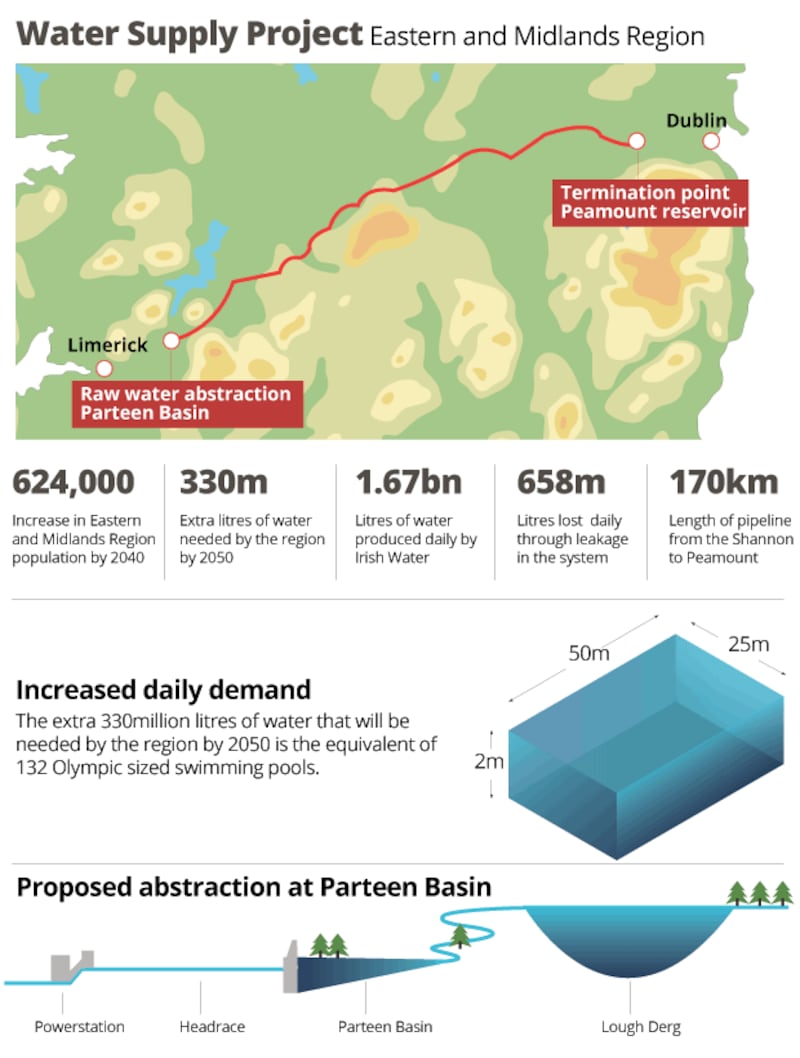Existing water supply sources "do not have the capacity or resilience to meet future requirements of homes and businesses in Dublin and the midlands", Irish Water concludes in its latest evaluation of the proposal to extract water from the river Shannon and to pipe it to Dublin.
The utility says extraction from the Shannon at Parteen, Co Tipperary, is best suited "to meet urgent water needs" of the greater Dublin and heavily-populated midland towns along the 170km pipeline route. The project is costed at €1.3 billion with a view to homes and businesses receiving the new supply by 2025.
The evaluation of “final options” includes analysis of the project based on new data and includes Irish Water’s detailed response to issues raised in the latest public consultation phase on the project.
It rejects all questions raised about the need for the project; recent criticism of its analysis of projected water needs for Dublin, and a failure to address the capital’s leakage problem which is among the worst in the EU.
The Water Supply Project – Eastern and Midlands Region (WSP) – "will deliver a secure, reliable and sustainable long-term water supply that will be critical to support the eastern and midlands region's social and economic growth from 2025", it adds.
Biggest upgrade
It will be the biggest upgrade to Ireland’s water source infrastructure in more than 60 years, ease overdependence on the Liffey, and ultimately provide an additional 330 million litres a day Irish Water says will be needed by the Dublin region by 2050 when its population is projected to grow to 2.1 million.
Communities in North Tipperary, Offaly, Laois, Westmeath, Kildare, Meath and Wicklow will also benefit from the project
The pipeline is intended to supply 40 per cent of Ireland’s population, which is concentrated in and around Dublin.
Following extraction at Parteen and treatment nearby at Birdhill, water will be piped to a termination point reservoir at Peamount in Co Dublin before connecting into the greater Dublin network.
Benefit corridor
Communities in North Tipperary, Offaly, Laois, Westmeath, Kildare, Meath and Wicklow, it says, will also benefit from the project with possible future off-shoots from the pipe that will enable the development of extra homes and businesses and increase potential inward investment.
Apart from the Greater Dublin Area (GDA), “the most urgent areas with impending water deficits in the region are the Mullingar supply area of Westmeath and the rapidly expanding area of east Meath bordering the GDA”, it notes.

Following its publication, Irish Water head of asset management Sean Laffey said: "The recently-published National Planning Framework confirmed the urgent need for a new long-term water supply source for the eastern and midlands region by the mid-2020s, to provide for projected growth up to 2050 and to ensure that the region has a safe, secure and resilient water supply for the region."
More than 1,000 stakeholders participated in the consultation and a wide range of issues were raised by the public.
If we continue to operate without the required headroom, we can expect more frequent water outages…
“Their engagement and input has helped us develop a long-term strategic investment project that we believe is environmentally sustainable and will bring economic benefits to the whole country,” he added.
Public confidence
Forecast population and economic growth would generate “a demand for an additional 330 million litres of water per day by 2050 to give both the GDA and the midlands regions the resilience and reliability of service that is essential to inspire public confidence and continue to attract economic opportunity”, Mr Laffey said.
An infrastructural deficit was made clear when Storm Emma struck Ireland recently and the Greater Dublin Water Supply Area was found to have "operational headroom" to meet peak demand of only 1.5 per cent, which resulted in large-scale water outages and water restrictions. This alone underlined the WSP "is very, very urgent", he said.
“If we continue to operate without the required headroom, we can expect more frequent water outages… In a properly functioning water utility, the target resource headroom should never be less than 13-15 per cent for major urban centres,” the report states.
Assessment of options over many years had identified “the Parteen Basin option delivers the widest benefit to the greatest number of people with the least environmental impact and in the most cost effective manner”, he said.
Next steps
The Government's recently published River Basin Management Plan spells out new water obligations under the EU water framework directive. Legislation is due to be ratified later this year to establish the Water Abstraction Registration and Licensing Authority. As a result, the WSP project will require an abstraction licence in addition to the planning application to An Bord Pleanála – now expected to be submitted in 2019.
An environmental impact assessment report and Natura impact statement are being prepared for submission with the planning application.
While Irish Water’s latest WSP report marks the formal end of consultation, it says it “will continue to meet with interested stakeholders to make sure we work together to deliver the vision of a safe, secure and sustainable water source for the eastern and midlands region”.
The feedback received and Irish Water's response are available at watersupplyproject.ie








